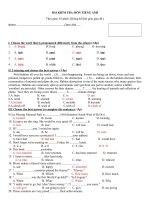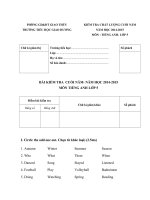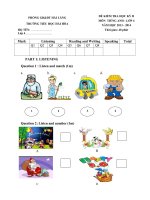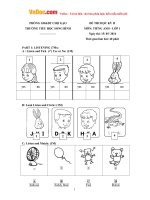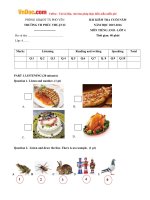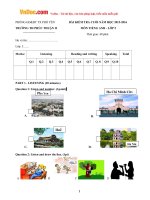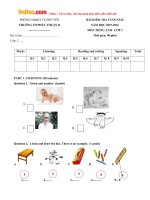ĐỀ THI HỌC KỲ 2 - ĐỀ SỐ 2 MÔN: TIẾNG ANH 7 GLOBAL SUCCESS
Bạn đang xem bản rút gọn của tài liệu. Xem và tải ngay bản đầy đủ của tài liệu tại đây (580.12 KB, 16 trang )
<span class="text_page_counter">Trang 1</span><div class="page_container" data-page="1">
<i><b>I. Choose the word whose underlined part is pronounced differently. </b></i>
<b>1. A. amazing </b> B. around C. against D. spacious
<b>2. A. serious </b> B. question C. stressful D. dense
<i><b>II. Choose the word that has a different stressed syllable from the rest. </b></i>
<b>3. A. atmosphere </b> B. melody C. carnival D. recommend
<b>4. A. allergy </b> B. depression C. unusual D. performer
<i><b>IIII. Choose the best option (A, B, C or D) to complete each of the following questions. </b></i>
<b>5. Good living standard helps people to __________ healthy and to live longer. </b>
<b>6. __________ youngest boy has just started going to__________ school. </b>
<b>7. Have you got _______pen, or would you like to borrow _________? </b>
A. your - mine B. yours - my C. yours - mine D. your - my
<b>8. What will our transport __________ look like in the future? </b>
<b>9. Emissions from vehicles have negative __________ on the environment. </b>
<b>10. The teacher is __________ a talk about how to save energy. </b>
<b>11. The festival is __________ every year at the end of October. </b>
<b>12. We adore winter _________ the cold. </b>
A. in spite of B. although C. however D. but
<b>13. That horror film is too __________ for me. </b>
A. hilarious B. frightening C. romantic D. moving
<b>14. Let’s __________ a look at the film section of the paper. </b>
<b>15. They often choose __________ cars with bigger engines to get higher speed. </b>
<i><b>IV. Write the correct form of the words in brackets. </b></i>
<b>16. When too many people live in a small place, __________ can become very difficult. (LIVE) ĐỀ THI HỌC KÌ 2 – ĐỀ SỐ 2 </b>
<b>MƠN: TIẾNG ANH 7 GLOBAL SUCCESS </b>
<b> BIÊN SOẠN: BAN CHUYÊN MÔN LOIGIAIHAY.COM </b>
</div><span class="text_page_counter">Trang 2</span><div class="page_container" data-page="2"><b>17. He is a __________ student because he goes to class every day. (REGULARLY) regular 18. Coal will be __________ by another renewable source of energy in the future. (REPLACE) 19. How many __________ are there in the program tonight? (PERFORM) </b>
<b>20. A man in a silver sports car __________ into a lady in a big blue truck in the middle of the intersection </b>
yesterday. (CRASH)
<i><b>V. Read the following passage and choose the best answer to fill in each blank. </b></i>
<b>You use energy every day. Energy is the ability (21) _______ change. When you ride a bike, you use energy from your body to make the bike move. Your parents use heat energy to change the food (22) _______ raw </b>
to cooked.
<b>Not all energy is used as soon as you get it. Sometimes energy is (23) _______ to be used later, stored energy </b>
can be chemical energy stored in a battery or in your body. It can also be potential energy. Potential energy
<b>is based on (24) _______ position of the object. A soccer player standing ready to kick a ball has potential </b>
energy.
Energy of motion is also called kinetic energy. Potential energy converts, or changes into, kinetic energy when the thing or person begins to move. When the soccer player kicks the ball, kinetic energy is at work.
<b>Energy often changes forms. When you (25) _______ the light, electricity converts into light. When you eat, </b>
chemical energy from your food converts into thermal and mechanical energy that allows you to move and
<b>25. A. switch off </b> B. switch over C. switch back D. switch on
<i><b>VI. Read the passage and decide whether the statements are True or False. </b></i>
Flying cars aren’t just science fiction anymore. Terrafugia, based in the United States, is developing a readable aircraft called the Transition. The vehicle has two seats, four wheels and wings that fold up, so it can be driven like a car. Terrafugia first began to work on the Transition in 2006 and has come closer than anyone to making the flying car a reality. The company uses special tires and glass that are lighter than normal automotive ones, which makes it easier for the vehicle to fly. An owner needs to pass a test and complete 20 hours of flying time to be able to fly the Transition. The Transition can reach around 70 miles per hour (mph) on the road and 115 mph in the air. On the ground, it gets 35 miles per gallon.
<b>26. The Transition has room for four passengers. </b>
<b>27. Terrafugia has worked on the Transition since 2006. 28. The flying car uses special tires and glass. </b>
<b>29. All drivers of the Transition will only have to pass a test to get a license. 30. The Transition will go faster in the air than on the road. </b>
</div><span class="text_page_counter">Trang 3</span><div class="page_container" data-page="3"><i><b>VII. Complete each of the following sentences using the cues given. You can change the cues and use other words in addition to the cues to complete the sentences. </b></i>
<b>31. Overpopulation/ bring/ many problems/ like/ crimes/ unemployment. </b>
<i><b>IX. Listen and complete the text with NO MORE THAN TWO WORDS. </b></i>
Overpopulation is a real problem. It could kill the Earth. Very soon, there will be too many people and not
<b>(36) ________. </b>
There won’t be enough farms to grow food for everyone. We’ll eat all of the fish in the sea. And our pollution
<b>will cause more (37) ________. I think we are in a very serious situation. </b>
<b>I don’t know what the answer is. Our leaders don’t seem too (38) ________. They never see the bigger picture. </b>
The world’s population is exploding, and explosions cause great damage.
<b>More and more people are living longer and longer. We have better (39) ________. Our scientists have found </b>
cures to many diseases. There are many reasons. What we really need to do is to think about how
<b>overpopulation (40) ________ the Earth. </b>
<b>---THE END--- </b>
</div><span class="text_page_counter">Trang 4</span><div class="page_container" data-page="4"><b>HƯỚNG DẪN GIẢI </b>
<b>Thực hiện: Ban chuyên môn Loigiaihay.com </b>
31. Overpopulation brings many problems like crimes and unemployment. 32. Modern means of transport are very strange to me.
33. Like any other type of power, solar energy has its own disadvantages.
34. Animated characters can be an animal, a tree, or any household item, and they can talk like human beings.
35. I had a trip to my hometown with my brother two days ago.
<b>HƯỚNG DẪN GIẢI CHI TIẾT </b>
</div><span class="text_page_counter">Trang 5</span><div class="page_container" data-page="5">Cụm từ “stay healthy”: giữ sức khỏe tốt
<b>Good living standard helps people to stay healthy and to live longer. </b>
<i>(Mức sống tốt giúp con người khỏe mạnh và sống lâu hơn.) </i>
Chọn B
<b>6. A </b>
<b>Kiến thức: Mạo từ Giải thích: </b>
Vị trí 1: Dấu hiệu so sánh nhất “youngest” (trẻ nhất) => cơng thức so sánh nhất với tính từ ngắn “young” (trẻ): S + tobe + THE + tính từ ngắn + EST.
Vị trí 2: Mạo từ a/an/ the không đứng trước danh từ khi hành động đến hoặc ở tại đó có liên quan đến mục đích chính của các địa điểm => khơng dùng mạo từ.
school (n): trường học
<b>The youngest boy has just started going to school. </b>
<i>(Cậu út vừa mới bắt đầu đi học.) </i>
Chọn A
</div><span class="text_page_counter">Trang 6</span><div class="page_container" data-page="6"><b>7. A </b>
<b>Kiến thức: Đại từ nhân xưng Giải thích: </b>
your: của bạn => tính từ sở hữu, đứng trước danh từ
yours (ai/ cái gì) của bạn => đại từ sở hữu, đóng vai trị chủ ngữ hoặc tân ngữ my: của tơi => tính từ sở hữu, đứng trước danh từ
mine (ai/ cái gì) của tơi => đại từ sở hữu, đóng vai trị chủ ngữ hoặc tân ngữ
<i>Vị trí 1: Trước danh từ chỉ vật “pen” (cây bút) cần một tính từ sở hữu => dùng “your” (của bạn) Vị trí 2: Sau động từ “borrow” (mượn) cần một tân ngữ => dùng “mine” (my pen). </i>
<b>Have you got your pen, or would you like to borrow mine? </b>
<i>(Bạn đã có bút của bạn chưa, hay bạn muốn mượn của tôi không?) </i>
<b>What will our transport system look like in the future? </b>
<i>(Hệ thống giao thông của chúng ta sẽ như thế nào trong tương lai?) </i>
Cụm từ “have effect on”: có ảnh hưởng đến
<b>Emissions from vehicles have negative effects on the environment. </b>
<i>(Khí thải từ các phương tiện giao thơng có tác động tiêu cực đến môi trường.) </i>
Chọn B
<b>10. C </b>
<b>Kiến thức: Từ vựng Giải thích: </b>
</div><span class="text_page_counter">Trang 7</span><div class="page_container" data-page="7">A. doing: làm B. taking: lấy C. giving: đưa D. making: làm
Cụm từ: “give a talk”: thuyết trình
<b>The teacher is giving a talk about how to save energy. </b>
<i>(Giáo viên đang thuyết trình về cách tiết kiệm năng lượng.) </i>
<i>Cấu trúc thể bị động thì hiện tại đơn chủ ngữ số ít “festival” (lễ hội): S + is + V3/ed + (by O) </i>
hold – held – held (v): tổ chức
<b>The festival is held every year at the end of October. </b>
<i>(Lễ hội được tổ chức hàng năm vào cuối tháng 10.) </i>
<b>We adore winter in spite of the cold. </b>
<i>(Chúng tôi yêu mùa đông bất chấp cái lạnh.) </i>
</div><span class="text_page_counter">Trang 8</span><div class="page_container" data-page="8">D. moving (adj): cảm động
<b>That horror film is too frightening for me. </b>
<i>(Bộ phim kinh dị đó q đáng sợ đối với tơi.) </i>
Cụm từ “take a look”: nhìn vào
<b>Let’s do a look at the film section of the paper. </b>
<i>(Chúng ta hãy xem phần phim của bài báo.) </i>
Chọn D
<b>15. B </b>
<b>Kiến thức: Từ vựng Giải thích: </b>
A. slower (adj): chậm hơn B. faster (adj): nhanh hơn C. smaller (adj): nhỏ hơn D. worse (adj): tệ hơn
<b>They often choose faster cars with bigger engines to get higher speed. </b>
<i>(Họ thường chọn những chiếc xe nhanh hơn với động cơ lớn hơn để có được tốc độ cao hơn.) </i>
Chọn B
<b>16. life </b>
<b>Kiến thức: Từ vựng – Từ loại Giải thích: </b>
<i>Trước động từ “can” (có thể) cần một danh từ đóng vai trị là chủ ngữ. </i>
live (v): sống => life (n): cuộc sống
<b>When too many people live in a small place, life can become very difficult. </b>
<i>(Khi có quá nhiều người sống trong một nơi chật hẹp, cuộc sống có thể trở nên rất khó khăn.) </i>
Đáp án: life
<b>17. regular </b>
<b>Kiến thức: Từ vựng – Từ loại Giải thích: </b>
</div><span class="text_page_counter">Trang 9</span><div class="page_container" data-page="9"><i>Trước danh từ “student” (học sinh) cần một tính từ. </i>
regularly (adv): thường xuyên => regular (adj): nghiêm túc
<b>He is a regular student because he goes to class every day. </b>
<i>(Anh ấy là một học sinh nghiêm túc vì anh ấy đến lớp hàng ngày.) </i>
Đáp án: regular
<b>18. replaced </b>
<b>Kiến thức: Từ vựng – Từ loại Giải thích: </b>
<i>Dấu hiệu nhận biết thể bị động “by” (bởi) => cấu trúc câu bị động với động từ khiếm khuyết “will” (sẽ): S + </i>
will + be V3/ed + (by O).
replace – replaced – replaced (v): thay thế
<b>Coal will be replaced by another renewable source of energy in the future. </b>
<i>(Than sẽ được thay thế bằng một nguồn năng lượng tái tạo khác trong tương lai.) </i>
Đáp án: replaced
<b>19. performances </b>
<b>Kiến thức: Từ vựng – Từ loại Giải thích: </b>
<i>Sau lượng từ “many” (nhiều) cần một danh từ đếm được số nhiều. </i>
perform (v): biểu diễn => performance (n): màn trình diễn
<b>How many performances are there in the program tonight? </b>
<i>(Có bao nhiêu tiết mục trong chương trình tối nay?) </i>
crash – crashed – crashed (v): tông vào
<b>A man in a silver sports car crashed into a lady in a big blue truck in the middle of the intersection </b>
yesterday.
<i>(Một người đàn ông đi chiếc xe thể thao màu bạc đã đâm vào một phụ nữ trên chiếc xe tải lớn màu xanh lam ở giữa ngã tư ngày hôm qua.) </i>
Đáp án: crashed
<b>21. B </b>
<b>Kiến thức: Dạng động từ Giải thích: </b>
</div><span class="text_page_counter">Trang 10</span><div class="page_container" data-page="10"><i>Sau “tobe able” (có khả năng) cần một động từ ở dạng TO V (nguyên thể). </i>
<b>Energy is the ability to cause change. </b>
<i>(Năng lượng là khả năng gây ra sự thay đổi.) </i>
<b>Your parents use heat energy to change the food from raw to cooked. </b>
<i>(Cha mẹ của bạn sử dụng năng lượng nhiệt để chuyển thức ăn từ sống sang chín.) </i>
<i>(Đơi khi năng lượng được lưu trữ để sử dụng sau này, năng lượng được lưu trữ có thể là năng lượng hóa học được lưu trữ trong pin hoặc trong cơ thể bạn.) </i>
- khi đối tượng được nhắc đến đã rõ ràng, xác định. - đối tượng nhắc đến là duy nhất.
<i><b>a/an: </b></i>
- đề cập đến đối tượng lần đầu tiên.
</div><span class="text_page_counter">Trang 11</span><div class="page_container" data-page="11">- nói về cơng việc của ai đó.
<i><b>Không dùng mạo từ khi đối tượng nhắc đến mang tính tổng qt, khơng cụ thể. </b></i>
<b>Potential energy is based on the position of the object. </b>
<i>(Thế năng phụ thuộc vào vị trí của vật) </i>
B. switch over: chuyển qua C. switch back : chuyển lại D. switch on: mở
<b>When you switch on the light, electricity converts into light. </b>
<i>(Khi bạn bật đèn, điện sẽ chuyển thành ánh sáng.) </i>
Chọn D
<b>Bài hoàn chỉnh: </b>
<b>You use energy every day. Energy is the ability (21) to cause change. When you ride a bike, you use energy from your body to make the bike move. Your parents use heat energy to change the food (22) from raw to </b>
cooked.
<b>Not all energy is used as soon as you get it. Sometimes energy is (23) stored to be used later, stored energy </b>
can be chemical energy stored in a battery or in your body. It can also be potential energy. Potential energy is
<b>based on (24) the position of the object. A soccer player standing ready to kick a ball has potential energy. </b>
Energy of motion is also called kinetic energy. Potential energy converts, or changes into, kinetic energy when the thing or person begins to move. When the soccer player kicks the ball, kinetic energy is at work. Energy
<b>often changes forms. When you (25) switch on the light, electricity converts into light. When you eat, </b>
chemical energy from your food converts into thermal and mechanical energy that allows you to move and work.
<b>Tạm dịch: </b>
<i><b>Bạn sử dụng năng lượng mỗi ngày. Năng lượng là khả năng (21) gây ra sự thay đổi. Khi bạn đi xe đạp, bạn </b></i>
<i>sử dụng năng lượng từ cơ thể để làm cho chiếc xe đạp chuyển động. Bố mẹ bạn sử dụng năng lượng nhiệt để </i>
<i><b>biến đổi thức ăn (22) từ sống sang chín. </b></i>
<i><b>Khơng phải tất cả năng lượng được sử dụng ngay khi bạn nhận được nó. Đơi khi năng lượng (23) được lưu trữ để sử dụng sau này, năng lượng được lưu trữ có thể là năng lượng hóa học được lưu trữ trong pin hoặc </b></i>
<i>trong cơ thể bạn. Nó cũng có thể là năng lượng tiềm năng. Thế năng dựa trên (24) vị trí của vật thể. Một cầu thủ bóng đá đang đứng sẵn sàng để đá một quả bóng có năng lượng tiềm ẩn. </i>
</div><span class="text_page_counter">Trang 12</span><div class="page_container" data-page="12"><i>Năng lượng của chuyển động còn gọi là động năng. Năng lượng tiềm năng chuyển đổi, hoặc thay đổi thành động năng khi vật hoặc người bắt đầu di chuyển. Khi cầu thủ đá quả bóng, động năng đang hoạt động. Năng </i>
<i><b>lượng thường xuyên thay đổi hình thức. Khi bạn (25) bật đèn, điện sẽ chuyển thành ánh sáng. Khi bạn ăn, </b></i>
<i>năng lượng hóa học từ thức ăn của bạn chuyển thành năng lượng nhiệt và cơ học cho phép bạn di chuyển và </i>
<b>Thông tin: The vehicle has two seats, four wheels and wings that fold up, so it can be driven like a car. </b>
<i>(Xe có hai chỗ ngồi, bốn bánh và cánh gập lại nên có thể lái như ô tô.) </i>
Chọn False
<b>27. True </b>
<b>Kiến thức: Đọc hiểu Giải thích: </b>
Terrafugia has worked on the Transition since 2006.
<i>(Terrafugia đã làm việc trên Transition từ năm 2006.) </i>
<b>Thông tin: Terrafugia first began to work on the Transition in 2006 and has come closer than anyone to </b>
making the flying car a reality.
<i>(Terrafugia bắt đầu làm việc trên Transition lần đầu tiên vào năm 2006 và đã tiến gần hơn bất kỳ ai đến việc biến chiếc ô tô bay thành hiện thực.) </i>
Chọn True
<b>28. True </b>
<b>Kiến thức: Đọc hiểu Giải thích: </b>
The flying car uses special tires and glass.
<i>(Ơ tơ bay sử dụng lốp và kính đặc biệt.) </i>
<b>Thơng tin: The company uses special tires and glass that are lighter than normal automotive ones, </b>
<i>(Công ty sử dụng lốp và kính đặc biệt nhẹ hơn so với ơ tơ bình thường,) </i>
Chọn True
<b>29. False </b>
<b>Kiến thức: Đọc hiểu Giải thích: </b>
All drivers of the Transition will only have to pass a test to get a license.
<i>(Tất cả những người lái xe Transition sẽ chỉ phải vượt qua một bài kiểm tra để lấy bằng.) </i>
</div><span class="text_page_counter">Trang 13</span><div class="page_container" data-page="13"><b>Thông tin: An owner needs to pass a test and complete 20 hours of flying time to be able to fly the </b>
The Transition will go faster in the air than on the road.
<i>(Transition sẽ đi nhanh hơn trên không so với trên đường.) </i>
<b>Thông tin: The Transition can reach around 70 miles per hour (mph) on the road and 115 mph in the air. </b>
<i>(Transition có thể đạt tốc độ khoảng 70 dặm một giờ (mph) trên đường và 115 dặm / giờ trên không) </i>
Chọn True
<b>31. </b>
<b>Kiến thức: Thì hiện tại đơn Giải thích: </b>
- Thì hiện tại đơn diễn tả một sự thật có hiện tại => cấu trúc thì hiện tại ở dạng khẳng định chủ ngữ số ít
<i>“overpopulation” (sự q đơng dân số) với động từ thường: S + Vs/es. - “and” (và) dùng để nối hai từ loại giống nhau. </i>
<b>Đáp án: Overpopulation brings many problems like crimes and unemployment. </b>
<i>(Dân số quá đông mang lại nhiều vấn đề như tội phạm và thất nghiệp.) </i>
<b>32. </b>
<b>Kiến thức: Thì hiện tại hơn Giải thích: </b>
- Thì hiện tại đơn diễn tả một sự thật có hiện tại => cấu trúc thì hiện tại ở dạng khẳng định chủ ngữ số nhiều
<i>“means of transport” (phương tiện giao thông) với động từ tobe: S + are + adj. </i>
- “strange” + TO somebody: lạ đối với ai đó.
<b>Đáp án: Modern means of transport are very strange to me. </b>
<i>(Phương tiện giao thông hiện đại rất xa lạ với tơi.) </i>
<b>33. </b>
<b>Kiến thức: Thì hiện tại hơn. Giải thích: </b>
- Thì hiện tại đơn diễn tả một sự thật có hiện tại => cấu trúc thì hiện tại ở dạng khẳng định chủ ngữ số ít
<i>“solar energy” (năng lượng mặt trời) với động từ tobe: S + Vs/es. </i>
- “type of”: loại
- Danh từ đếm được số nhiều cần ở dạng thêm s/es.
<b>Đáp án: Like any other type of power, solar energy has its own disadvantages. </b>
</div>